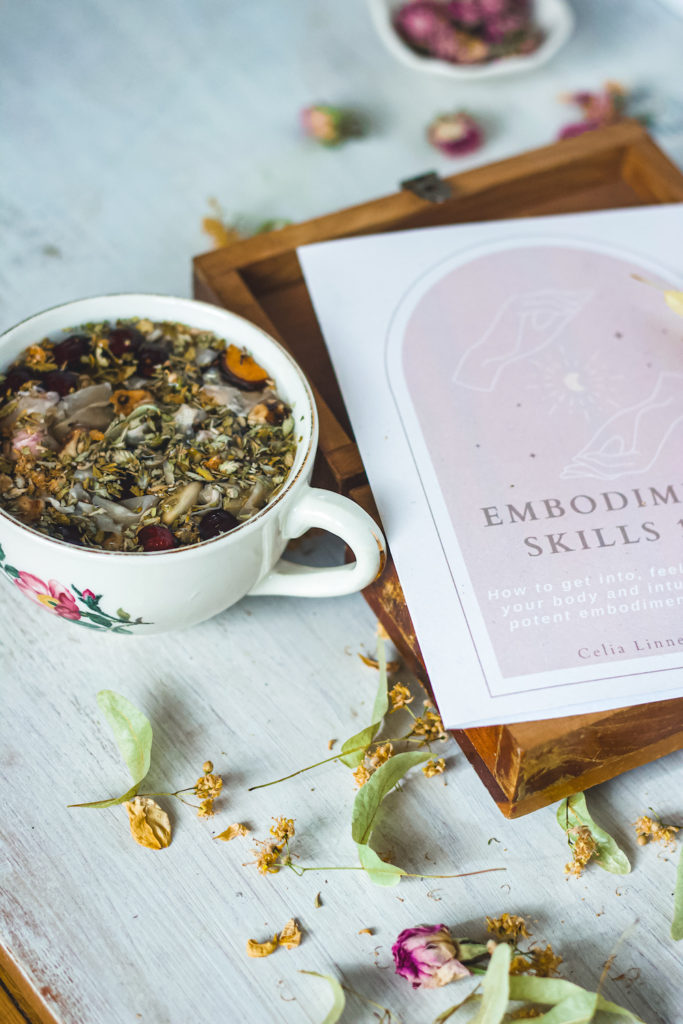5 things you need to know about an Embodiment practice
Embodiment is a funny word. We are already embodied just by having a body – so why would you want to spend time to practice embodiment? In this article, I will address the basics about what you need to know about embodiment from the get go.
I have my own reasons for practicing embodiment, but an embodiment practice can mean many different things to different people. Right now I am using embodiment skills to help me cope and manage having both physical pain and exhaustion. But during other times, I practice embodiment for different reasons.
You, too, will have your own unique constellation of reasons to be attracted to practicing embodiment…and what you define as an embodiment practice in the first place.
To me, an embodiment practice is returning to feeling into the body again and again. It is basically like pausing for a moment, taking a few breaths, bringing our awareness into your body and saying Hello, how are you today?
Embodiment is like a relationship. It is like kin-keeping with your body.
My hope is that you will walk away from this article feeling into your own foundations to what embodiment is and what an embodiment practice entails. I have my own observations about embodiment and how it can help us help you on the path of healing, transformation and connecting to your guidance system, but I want you to know that this is not about obtainment of anything (including healing!) or perfection.
Check out my embodiment guide
I have created a free guide about embodiment – check it out here to get your copy!
In it I walk you through an embodiment practice I call the Elevator Exercise for getting your awareness into your body (and moving it around), plus much more.

Let’s get into the basics – ready?
1. You need to know what Embodiment is
Seems obvious – but what is embodiment anyways?
The definition of embodied is a tangible or visible form of an idea, quality, or feeling in the Oxford dictionary.
From Merriam-Webster: Definition of embody, transitive verb
- 1: to give a body to (a spirit) : INCARNATE
- 2: to make concrete and perceptible
- 3: to cause to become a body or part of a body : INCORPORATE
- 4: to represent in human or animal form : PERSONIFY
I love these definitions, because (not surprisingly) it describes what is going on when you do embodiment practices: you feel your non-physical self, whether it is your emotional body, mental body, or spiritual/energetic body (or a mixture thereof) within your physical body.
Embodiment is when we bring our awareness into our body, and feel into it in whatever way we chose, however we chose.
Through this being with our body and paying it some attention, we feel – and experience – how all the different levels of our body are within us. We feel how our spirit is connected with our body.
We can put technical names on areas that involve embodiment. Here are some terms used to describe embodiment-like practices. Some are closer to what I see as embodiment than others.
Practices/techniques associated with Embodiment
- The realm of psychoneuroimmunology, or behavioral neuroscience
- This techniques 4 Square Breathing is part of embodiment (from the military)
- Somatic feedback (what psychologists call it)
- Body Talk or variations thereof (what bodyworkers call it)
- Different forms of Meditation (what spiritual communities call it)
- MBSR (mindfulness-based stress reduction – what Ivy League universities call it)
- Another technique: Heart-rate variability, HPA Axis or Vagus nerve adaptability (what white-coat researchers in labs call it)
- Guided relaxation (what the self-help community calls it)
- Medical intuition (what itutive body readers call it)
What associate these tools, modaities or practices is that they share some or all of the basic embodiment skills.
Basic Embodiment Tools
- Breathing – Three conscious breaths can reduce those stress hormones
- Sensing – Info/data you gather about your body
- Feeling – How your body feels right now
Some of the modalities listed above have more of a diagnostic, therapeutic orientation orientation above and beyond embodiment. I absolutely love gathering information from the body and being engaged in a healing process, but I want to stress that embodiment is not about solving problems or fixing anything.
However, embodiment can be very therapeutic – in fact, there have been times where tapping into my body has been the only thing that offered me any bit of lasting relief or healing.
Doula-ing yourself through embodiment
I protest that embodiment is like being your own doula for everyday life.
Let’s talk about birth doulas just for a sec so you can see where this comparison is coming from. Birth doulas are supportive and there for the birther. They are not birthing the baby, and they are not a midwife either and tending to medical needs. They are not making anything happen, but sometimes they may facilitate a type of space and support that is indeed helpful for the birther. Because of that, the outcomes of a birth may indeed shift and the medical needs of birther and baby may be addressed by having a doula – research shows this.
Sometimes a birth doula is really hands on, and other times the birth doula is like a fly on the wall. Regardless of physical and emotional involvement, they doula is a witness to the what the birth and early postpartum. They are a support person, they are non-judgmental.
A doula may be invested in helping the birther uphold their birth plan, and they are equally as supporting if the birth did not go as planned.
Can you see how we can be our own impartial yet supportive, witnessing doulas for our everyday life? Embodiment is one way to show up on our own door. During an embodiment meditation, we are essentially saying, I’m here to listen to you if you want, and see how you are feeling, if you’d like to share.

2. We are already embodied because we exist
I would love for you to know that you are already embodied.
We are all inherently embodied by having a body. It is not a separate state, or something outside ourselves. It’s pretty basic: we have non-physical aspects of ourselves that are anchored into our physical form from birth to death.
You can actively engage in embodiment practices to nurture the embodied nature of your being. Through the day, you eat, rest, walk or move if you are abled in that way, engage with others, work, play, do chores – those are all things where we can bring into our embodiment practices.
The other way we engage with our embodied nature is through specific embodiment practices which is like a meditation. This practice revolves around feeling into our body, and if it feels right, listening to it.
3. Your reasons for practicing embodiment
Why do you want to be embodied?
You don’t have to have it all figured out. But try to feel out your own reason for embodiment. Although it will adapt and change over time, you have to have a connection to the reasons why you even want to practice embodiment.
There are SO many reasons to get embodied. Do not limit yourself to what somebody else says about it – including me.
I reflect what I have learned about having an embodiment practice in my work as a starting off place. I do this with my work as an herbalist, too. An herbal protocol is not the one and only way to do something, it is for inspiration for you to develop your own protocol – whether it is with formulating an herbal tea for a cough or practicing embodiment.
I have found that embodiment can help us in three ways. Again…this is not set in stone! I think it gives an example of the range of possibilities of embodiment.
Common reasons for an embodiment practice
- Help with coping, managing, healing something physical like pain, nausea, discomfort, illness
- Help with listening to the emotions and to hold space for deep healing of the non-physical parts of ourselves, like healing self-esteem/self-worth, trauma, shadow work, cultural wounding like shame
- Connecting with guidance and intuition
I go over these a little more in the free guide – click here to learn about it and to have a copy sent to you.
4. Embodiment takes a little bit of time and space to practice
You need to know that in most cases, having embodiment practice will require you to spend time to lay down/sit comfortable and sink your awareness into your body.
To me, embodiment is not the same as meditation, but I often call it “body meditation” because it paints a picture of someone listening inwards. You need some space and time to be with yourself.
For me that is about 10-20 minutes of tuning into my body while laying down. How much time are you interested in spending during an embodiment meditation? When can you easily do this through your day?
Find your time
My favorite time to do my embodiment practice is during times I am laying down anyways. For me, that was when I used to put my kids to nap, when I need a rest or two or three during the day (I lay down a lot as I recover from chronic infections), when I put my kids to bed, and when I go to sleep myself.
When I have been in times of a lot of pain and illness, like when I was bedridden with pain and migraines for about 5 days of each week for 3 months with a Lyme flare, I did a LOT of embodiment. It was the only thing I could do, sometimes. When I was in 2-3 days of intense dysmenorrhea, I was basically in a state of embodiment meditation the whole time that I wasn’t drifting into sleep or hobbling around the house, moaning.
It makes sense I would do more embodiment during those extreme times of pain. Pain literally calls you into your body.
A lot of times, pain or illness knocks you on your back. You are already in bed and can’t do anything else – why not direct some breaths into that pain as you desperately try to figure out a way to make it through?

A note about pain
I certainly do not wish anyone to have excess pain, and I think we need to work to end needless suffering in so many ways. I have to say that before it starts to seem like I am glorifying pain. But there is something to the nature of wounding and pain that calls you back home to the spirit world, to your helpers, to something greater than you. In that way, pain can be a great healer to the suffering you may have, because in the arms of the divine you see it was never about you.
The pain brings you into your humanity, too. It is a way that we learn we are good enough, worthy enough, valuable simply by existing, and there is nothing that can ever happen to us in Earth school to take your humanity or worth away. It is inherent.
Ugh. This still makes me very aware of all the people who have, who still are and who will have pain that is needless and preventable. That is not justified. To honor pain does not mean we moralize it or make it some sort of spiritual currency. It simply means we honor it, just as we can honor both birth and death. Pain can be a teacher, just like anything else.
Embodiment practices for times of crisis/ungrounding/transformation
I do just as much embodiment practices when I am in times of intense mental-emotional-spiritual coping/managing/healing, too. Embodiment can be a great source of healing of things like trauma, shadows, past lives, ancestry, retrieving soul parts or limbic system dysfunction (definitely seek support if you are healing these things and they are causing pain or stress that is taxing you beyond your capacity to tend to).
Or should I say…I try to practice embodiment during these situations.
It is much harder to make the time to lay down and listen to my body during these times than when I am in pain, however. My focus is scattered. I feel very ungrounded. I try my usual getting into my body practices and they don’t work. I feel like a live wire – it’s hard to rest into myself. Sometimes I will try to get embodied, but I just can’t feel into my body. That is totally okay and normal – it is not about perfection or results, even.
But I keep trying, usually focusing on one little aspect of the breath, like a pin-point small area of where the air touches my nostrils. I add in counting of the breath, it helps extend the focus.
If you feel like this, tend to your nervous system continually. Eventually it will start to stabilize, and then even ramp down.
Ritual, prayer, dance, creative expression, going into nature, dreaming, eating, and of course speaking with a loved one or being with plants or animals can help, too. My go-to is an epsom salt bath followed by herbal SJW or Lavender oil massage, then drink some tea, like Skullcap. Then I’d tuck into bed and take as many breaths as I can manage to focus on.

5. Embodiment is about a relationship, and can have good results, but it is not from MAKING anything happen
This is one of my favorite things to know about an embodiment practice: it CAN assist us on our path of our deepest healing, but it cannot be forced.
Why is this my favorite? Because it frees you up to not have to make anything happen. You can let go of the have-tos. the goals, the needs, the pressure of having to figure everything out. You can just be with your body.
Embodiment is a relationship. You do not manage a relationship, you just enjoy them.
It is true that sometimes we need to kin-keep, and give and receive within a relationship. We may choose to be there for our friend or child or family to offer extra support. We may shower our friends with love and compliments. We may tell them how we accept them and are proud of them. We may be there when they need us.
But most of the time, there is little we can do to force them to be a certain way. We are just their friend and we support them.
Have you ever had a life-changing conversation with a friend? That sort of thing may happen between us and our body, and so much more.
Maybe our body comes into a teacher role, or maybe we are like a self-parent when our body is speaking to us through emotions from a traumatic childhood experience. Even within the role of being a self-parent there is great flexibility and adaptability, these are not strict, restrictive societal roles or media portrayals but more like archetypes.
So there you have it…
Embodiment is a big topic because it contains what it means to be alive in a body. These were just a few basic things to know about an embodiment practice.
But embodiment is also quite simple because we are just that – we are embodied simply by being here. If you feel drawn to exploring the body-spirit interface, embodiment practices can get a sense of what your body and being are feeling and what they have to say.
My hope is that you will walk away knowing exactly what embodiment is so you can feel more more confident to invest the small amount of time and space it takes to get into your body to help you on the path of healing, transformation and connecting to your guidance system.
Check out my embodiment guide!
If you want to learn more about the basics of embodiment, make sure to check out my free guide.











2 Comments